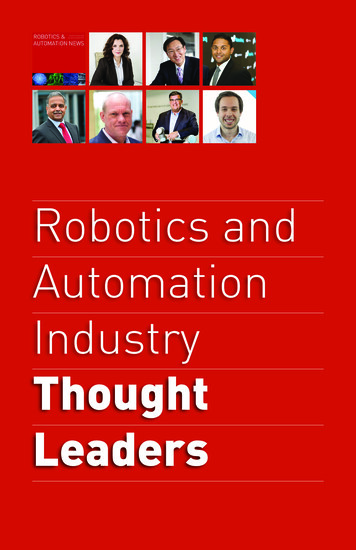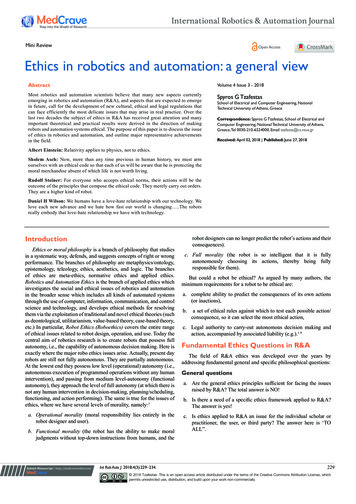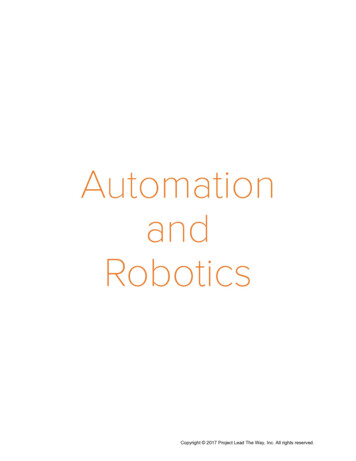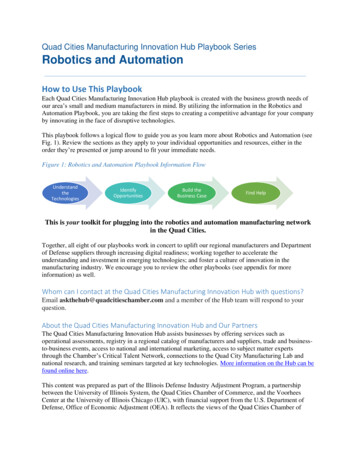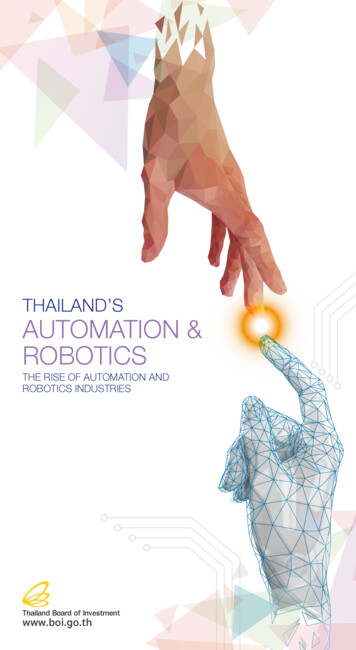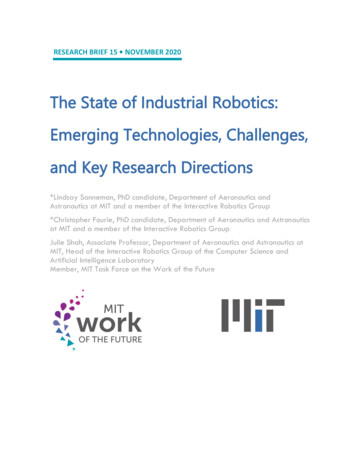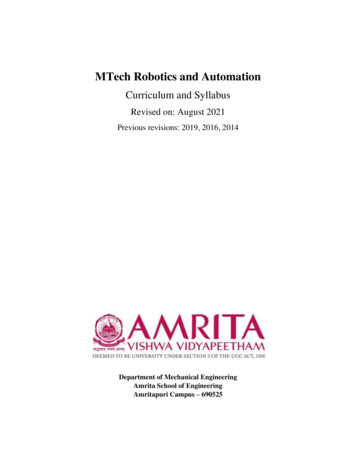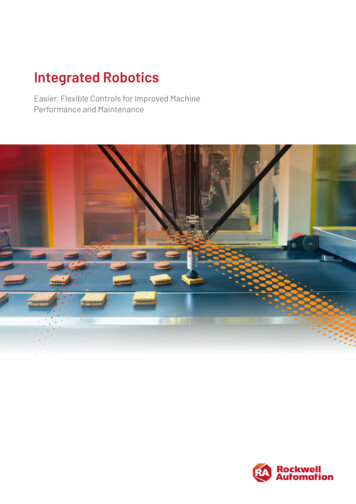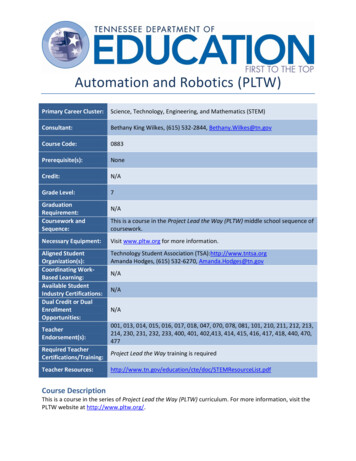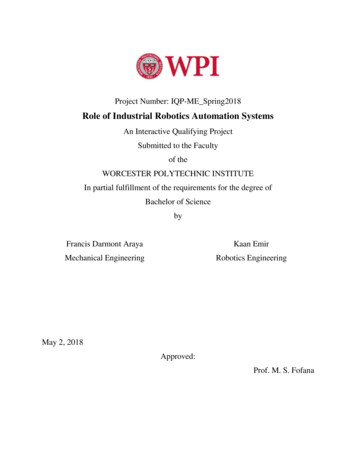
Transcription
Project Number: IQP-ME Spring2018Role of Industrial Robotics Automation SystemsAn Interactive Qualifying ProjectSubmitted to the Facultyof theWORCESTER POLYTECHNIC INSTITUTEIn partial fulfillment of the requirements for the degree ofBachelor of SciencebyFrancis Darmont ArayaKaan EmirMechanical EngineeringRobotics EngineeringMay 2, 2018Approved:Prof. M. S. Fofana
AbstractThis Interdisciplinary Qualifying Project focuses on the role of robots in increasing safety,productivity and profit for four specific industries. These industries include manufacturing,medical, construction and food packaging. In the manufacturing industry, robots are used primarilyin welding process, material handling systems and inspection of parts. Some of the robots usedinclude Fanuc LR200i, Fanuc R20000iC and Motosight. The technical specifications of theserobots range from an end effector payload of approximately 25-210 kg, distance reach of 717-2650mm and power of 200-575 volts. In the medical industry, robots are used in surgical and sanitationapplications. Examples of these robots include the Da Vinci and Xenex. A notable specification ofthe Da Vinci robot is its capability to provide seven degrees of freedom at its end effector. In theconstruction industry, robots are used to improve worker safety and structure of the building.Robots as the SAM 100 and the Oscar 100 provide a wide range of end effector capabilities ofapproximately 2,000 to 3,229 mm. In the food packaging industry, robots are used primarily forpicking, packing and palletizing finished products. Some of these robotic systems include IRB340, IRB 260 and the IRB 660, which are manufactured by ABB. Their payload capabilities areapproximately 1-250 kg and they are used for wide range of packaging operations. A cost analysisshows that the incorporation of robotic systems into the four industries reduce labor andoperational costs, and improve performance substantially. In many robotic system, translational,rotational and simultaneous translation and rotational motion may be required to move or orientloads. The motion planning, selecting suitable mechanical components and electrical powersystems for robots with many degrees of freedom demand several design iterations. Paths, speedsand orientations of robots are controlled by motors embedded with software, hardware andelectronic amplifiers. A prototype robot for welding process is designed and built. This providethe IQP team an opportunity to apply basic engineering experience to industrial robotic systems.A detailed engineering drawing of the prototype welding robot is presented. The IQP team usedthe robots in WPI Washburn machine shop to gain hands-on experience of pick and place robotsand measurement of machined parts using robots. Recent developments in the role of roboticsystems in manufacturing, medicine, construction and food packaging are also presented. Theliterature dealing with robotic systems show that there is a growing effort to increase roboticsystems in many other industries. Robots are found to reduce accidents in the work place and themaking of defective parts. The societal impacts of this IQP are the robots improve performance,increase safety and reduce costs.ii
Table of ContentsABSTRACT. IITABLE OF CONTENTS. IIILIST OF FIGURES . VLIST OF TABLES.VIACKNOWLEDGEMENTS .VICHAPTER 1. THE ROLE OF ROBOTS IN MANUFACTURING INDUSTRY . 11. INTRODUCTION . 1CHAPTER 2. APPLICATIONS OF ROBOTS IN FOUR INDUSTRIES . 32. INTRODUCTION. 32.1. Application of Robots in Manufacturing Industry . 32.1.1 Spot and Arc Welding Processes . 32.1.2 Material Handling in Automated Assembly Operations . 52.1.3 Faulty and Defective Products Inspection . 62.2 Application of Robots in Medical Industry . 72.2.1 Non-Intrusive Surgical Procedures . 82.2.2 High Precision Implantation Cochlear Implantation . 92.2.3 Hospital Sanitation Assistance . 112.3 Application of Robots in Construction Industry . 122.3.1 Worker Safety Mitigation . 122.3.2 Structure Assembly Operations . 132.3.3 Wearable Exoskeleton for Reducing Strain . 142.4 Application of Robots in Food Packaging Industry. 142.4.1 Picking Products in Conveyor Belt . 152.4.2 Packing Products in Large Quantities . 152.4.3 Palletizing and Relocation . 16CHAPTER 3: FINANCIAL ANALYSIS OF ROBOTS IN THE INDUSTRY . 173. INTRODUCTION. 173.1 Cost Comparison of Robots vs Humans . 173.2 Impact on Labor Costs of Manufacturing . 203.3 The Decline of Robot Costs . 213.4 Robot Systems Demand Increase . 22iii
CHAPTER 4. DESIGNING AND BUILDING A WELDING ROBOT . 244. INTRODUCTION. 244.1 WPI Washburn Robot Systems . 244.1.1 FANUC LR Mate Model Familiarization . 244.1.2 FANUC LR Model 200iB Specifications . 254.1.3 Research Welding Experience . 264.2 Researching Forces of Robotic Systems . 284.2.1 Base Slider Calculations of Associated Forces . 294.2.2 Robotic Arm Calculations. 304.2.2 End Effector Force Calculations . 314.3 Welding Robot Prototype Design and Assembly . 324.3.1 Materials Utilized on Prototype Design . 324.3.2 Assembly Instructions of Prototype Design . 324.3.3 Operational Instructions of Prototype Design. 33CHAPTER 5. CONCLUSIONS AND DISCUSSION . 35REFERENCES . 36APPENDICES . 38Appendix 1. FANUC Controller Specifications . 38Appendix 2. Welding Robot Prototype Engineering Drawings . 39Appendix 3. Stepper Motor Hardware . 42Appendix 4. Welding Robot Prototype Operational Code. 43iv
List of FiguresFigure 1. LR-Mate 200iD and ARC Mate . 5Figure 2. Fanuc R20000iC Component Robot. 6Figure 3. Visual Inspection System Depiction. 6Figure 4. Real-time Compensation of the Lateral Tool Deviation . 7Figure 5. FANUC Weldment: Corrected Path (Blue); Real Path (Red) . 7Figure 6. Da Vinci Robot by Intuitive Surgical . 8Figure 7. Cochlear Implantation . 9Figure 8. Cochlear Implantation Procedure . 10Figure 9. Surgical Robot for Cochlear Implantation. 11Figure 10. Robotic Safety Barrel . 13Figure 11. SAM100 Construction Brick Robot . 13Figure 12. Oscar 100 Glazing Robot . 14Figure 13. IRB340 FlexPicker Picking Robot . 15Figure 14. IRB260 Packing Robot . 16Figure 15. IRB660 Palletizing Robot . 16Figure 16. Labor Cost Saving Graph . 20Figure 17. Robotic Systems Cumulative Cashflow Over Years . 21Figure 18. Industrial Robot Cost Decline . 22Figure 19. Worldwide Annual Supply of Industrial Robots . 22Figure 20. FANUC System Controller R-J3iB . 24Figure 21. FANUC LR MATE Robot . 25Figure 22. Teach Pendant for FANUC Robot System . 25Figure 23. TIG Welding Technician Position . 27Figure 24. Slider Free Body Diagram . 29Figure 25. Arm 1 Free Body Diagram with Associated Forces . 30Figure 26. End Effector Free Body Diagram . 31Figure 27. Complete Robot Arm Representation. 28Figure 28. Isometric View of Prototype Robotic Arm. 33Figure 29. Micro Servo Hardware Dimensions . 34v
List of TablesTable 1. Cost Comparison Between Humans and Robots . 18Table 2. Robotic System Cash Flow Analysis . 19AcknowledgementsWe would like to acknowledge Professor Fofana for his continued support and patiencethrough this research process. In addition, we would like to thank the Washburn Laboratories stafffor furthering our knowledge of the operation of robotic components and welding equipment.Lastly, we would like to thank our families for providing the financial and emotionalsupport needed to stay consistently motivated through the research process and report formulation.vi
CHAPTER 1. THE ROLE OF ROBOTS IN MANUFACTURING INDUSTRY1. IntroductionThere is a growing interest in using robots in various industries. This interest stems fromthe fact that robotics helps to increase safety in the workplace, increase productivity and reduceproduction costs. With robotic applications, significant amount of labor work can be doneautonomously. Advanced sensors in robots allow high precision tasks that are difficult for humanworkers to be done. Therefore, higher qualities for products and services are achieved when robotsare used. There are robots developed specifically for manufacturing industries, applications inmedicine, food production, agriculture and construction industry. These robots can be used formany different tasks, such as welding process in automotive industry, painting automobilecomponents and inspection. Industrial robots provide better efficiency in manual labor and usuallyhave the ability to run 24 hours per day. These benefits greatly reduce production costs forcompanies in long term since they don’t have to employ a group of workers to do the same job.Many surgeries can be carried out by robots or co-operation between human doctors and robots.Medical robots in hospitals can autonomously do the initial stage of cochlear implantation surgery,which is drilling the skull with high precision. Hospitals are also interested in implementing robotsthat directly cooperate with doctors and act as robotic tools. Doctors can control these robotsdirectly from a control unit and work with enhanced vision and robotic arms with high precision.Surgeries done with this method can improve recovery time in patients and minimize the damageto the body, providing a safer surgery and higher quality treatment. Industrial robots that are mainlybuilt for people’s safety conduct communication through hand gestures between workers, so thatworkers can receive input from robot easily when there is distance in between and noise in theenvironment. These robots are expected to decrease overall cost in long term, improve safety ofpeople and have better and more consistent quality in products and services. It is the purpose ofthis project to investigate robots that are used in different industries and their roles in companies.The main goal of this project is to describe the roles of robots in various industries andtheir social impacts. This includes how robots can carry out tasks autonomously to reduce manuallabor, or how robots can be used in high precision requiring tasks to produce better results thanhumans. Robots can have significant social impact by doing tasks that can be dangerous for human1
workers. This reduces potential employee injuries and allows employees to work on safer tasks.The project also focuses on financially analyzing robots that are used in companies to determinelong term benefits and possible financial challenges of using robots. Despite being used indifferent fields, it is determined that robots from various industries have a certain group of commonaspects. This project focuses on evaluating robots in these industries under their impact on costs,quality and safety; which mainly the common aspects of different robots. In addition, the IQP teamis aiming to is to learn more about robotic systems and the engineering behind it by making aprototype robotic arm and analyze its kinematics. Therefore, overall objective of this project is todetermine the role that robots serve in different industries and learn more about their design withhands on experience and training.In the initial phase of this IQP, a prototype robotic welding arm has been created andmathematical analysis of dynamics and kinematics of the robotic arm has been conducted.SolidWorks is used to model the components of the robotic arm and 3D printed them to physicallyassemble them. Arduino Mega 2560 is used as a microprocessor to control the arm. To learn moreabout the welding process, appropriate training from WPI Washburn labs is received by the IQPteam. Armed with that knowledge, an extensive research has been done about robots and theirroles that are used in manufacturing industry. A set of examples of robots from various industrieshave been gathered. Their impact on cost, quality and safety have been analyzed thoroughly. Theway medical robots perform and improve surgery results have been investigated. A comprehensivecost analysis for industrial robots have been made. Financial concepts such as return of investmentfor mid-size industrial robots and estimations of average costs for industrial robots in future havebeen evaluated. The IQP team has researched about safety systems implemented in robots andlearned about their impact on safety improvement. In chapter 2, examples of robots frommanufacturing industry, medicine, construction industry and food packaging industry are providedto discuss their advantages and technical capabilities. In the next section, the project focuses onrobots used in medical applications and robots with safety systems to minimize foreseeableinjuries. The cost analysis on examples of manufacturing robots in companies is demonstratedalong with discussing the estimations of manufacturing robot market in U.S.A. In Chapter 3, theproject focuses on IQP team’s welding training in WPI Washburn Labs and the designing processof the prototype robotic arm followed by kinetics and kinematics equations with free bodydiagrams of the prototype robotic arm.2
CHAPTER 2. APPLICATIONS OF ROBOTS IN FOUR INDUSTRIES2. IntroductionThe use of robots in the manufacturing, medical, construction and food packaging industryhas benefited companies in increasing safety, productivity and reducing production costs. Theincrease in demand of such robotic systems, has allowed for robot manufacturers to increase thevariety of robotic systems in the market. In addition, increased competition in the market haspressed manufacturers to provide innovative solutions that reduce costs and meet the needs of theindustry. This financial benefit has incentivized companies to keep themselves informed on thelatest technologies. For companies to narrow down applicable technologies, is essential to analyzeand understand the specifications and benefits that each robot can provided. Although not all robotsystems are explained in this chapter, this chapter intends to provide information of the variety ofrobots that are used in four major industries. In addition, specific specifications are provided foreach robot that are considered of most importance when considering overall costs and benefits.2.1. Application of Robots in Manufacturing IndustryRobots are widely used in the Manufacturing Industry for different processes andoperations. Within the many processes, the most prominent areas of robot utilization includewelding, material handling and inspection. The utilization of robots in these areas aid inperforming hazardous and repetitive tasks that increase risk to employees and reduce the qualityof the finished product. Due to the advance in technology, robot utilization in areas of inspectionhave provided increased capabilities that are not affected by the human factors as concentrationand motivation. In addition, the ability to reduce overall production time and costs through roboticsystems has become a strong force for implementing these systems.2.1.1 Spot and Arc Welding ProcessesThe process of robotic welding has gained traction over the years especially in the automotiveindustry. The welding versatility of robots has provided applications in arc welding, tungsten inertgas welding and spot welding. Details of the seven major robot manufacturers in the industry areprovided in the list below [6]. Yaskawa: Motoman robotics3
o Total of 15 welding robotso Largest diversities of robotso Payloads 3 kg to 15 kg. Fanuc Roboticso Robots on railso “ARC Mate” designation (branding)o Total of 11 welding robots ABB Companyo Total of 2 welding robotso Recognized by letters ‘ID’ at the end of their name Kuka Companyo Robots and robotic accessorieso Smaller collaborative to 1,300 kg payloado Hollow wrists, install a welding torch or feed material Kawasakio 7 welding robotso ‘RS’ designation before their name Comauo Italian companyo Build automotive body welding cellso Spot welding background Panasonic, Cloos, Nachio Small Arc welding robot lineThe LR- Mate 200iD and ARC Mate 0 iB robots provide some of the highest capabilitiesin the welding industry. As shown in Figure 1 below, the robots are set up for coordinated motionto efficiently weld a range of parts and detect any discrepancies using accessory systems like theIR vision [12]. The synchronized movement of the two robot arm and the degrees of freedomspecifications (DOF) allow for a faster welding process to occur. In addition, allowing for acontinuous welding process to occur without having to reposition the part, provides a noticeablereduction in production time and costs. Some of the specifications of this robot include:4
DOF: 6 Reach: 717 mm Weight: 25 kg Payload at Wrist: 7 kg Controller: R-30iB Power: 200-230 VFigure 1. LR-Mate 200iD and ARC MateThe performance capabilities of this robot are advertised by the manufacturer to increasein “optimization of energy and a reduction of cycle time by 15%” [12]. In March of 2016,Hypetherm Inc. incorporated this robotic cell into their industrial cutting equipment. Their resultsexceeded the manufacturer’s expectations by providing an overall production output “increase of200 percent, a 50 percent increase in operator output and reduced scrap by 50 percent” [18].2.1.2 Material Handling in Automated Assembly OperationsThe movement of components in the manufacturing industry plays a major role insupporting repetitive roles. A robot model known as the Fanuc R20000iC (Figure 2) is widely usedin the industry specifically in automated assembly operations due to its high payload capabilities[12]. Some of the additional capabilities of this robot model include transporting devices (materialhandling of work pieces between machines), additive- (e.g. assembly, welding, gluing, painting)and subtractive- manufacturing process (e.g. milling, cutting, grinding, deburring, polishing) [8].Some additional technical specifications of this robot include:5
DOF: 6 Reach: 2655 mm Weight:1370 kg Payload: 210 kg Input Power: 380-575 V Controller: R-30iBFigure 2. Fanuc R20000iC Component Robot2.1.3 Faulty and Defective Products InspectionShipping faulty or defective products can have devastating effects in the success of anymanufacturing business. Machine vision has a long history in part inspection, ensuring consistentand predictable quality. Whether it’s gauging a part, detecting presence of a feature or errorproofing, MotoSight systems have all the necessary inspection and data analysis tools for partinspection. Their inspection interface software shown in Figure 3, provides a detail view to theoperator of the part being analyzed and any resulting flaws detected in the process.Figure 3. Visual Inspection System DepictionA study from Institute Maupertuis compared welding quality of a Robotic Friction StirWelding (RFSW) arm and a CNC system. Gantry-type CNC machines offer high stiffness andthey can tolerate high forces during FSW. There is an effort done by companies to replace themwith industrial serial robots to increase process flexibility and reduce cost investment. However,6
there are two limitations that should be considered. The first one is the payload capability ofindustrial robots which limits the welding thickness up to 8 mm for aluminum materials. Secondone is low stiffness of robotic joint, therefore deformations that occur to FSW tools under highprocess forces which impact the welding quality. To compensate for the deformations, a real-timeembedded controller calculates the deviations in tools and improves welding quality.In the CNC machine experiment, good welding quality was not obtained due to high forceson the CNC system creating deviations in the welding path as shown in Figure 4 and Figure 5. InRSWF this problem is overcome by having an algorithm to compensate for the deviations in realtime. Program takes a while to correct itself back to the right path while still welding, however,researchers concluded that overall quality was improved in RFSW application.a) Reference pathb) Tool Deviationc) Tool CompensationFigure 4. Real-time Compensation of the Lateral Tool DeviationFigure 5. FANUC Weldment: Corrected Path (Blue); Real Path (Red)2.2 Application of Robots in Medical IndustryThe medical industry has also had an increase of robotic systems implementation. Althoughreduction of costs is typically the driving force for such expensive implementation, increase patientrecovery and reducing complications has also become of immense importance. In addition, theincrease of liability insurance and medical costs has driven companies to streamline their processesacross all areas of medicine. The following robot assembly analyzed have been found to have a7
direct impact in the quality of patient care. In addition, they have provided more ergonomicpostures for surgeons and increased motion precision. Other non-surgical robotic systems haveallowed for an increased sterilization of medical floors with consistent and measurable results.Systems as these can reduce human errors associated with performing strenuous repetitive tasks.2.2.1 Non-Intrusive Surgical ProceduresThe application of robotic systems in surgery has increased over the past years.Specifically, surgery procedures such as cystectomies have greatly benefited from the advancedcapabilities of these robots. A robot having beneficial and consistent results on surgical operationsis known as the Da Vinci, manufactured in 2000 by Intuitive Surgical. An image of the robot isprovided in Figure 6 below.EndowristFigure 6. Da Vinci Robot by Intuitive SurgicalThe entire system is composed of a surgeon console, a patient side car and endowristinstruments. One of the many outstanding capabilities of this robot is its 7 degrees of motion at itsendowrist end effector [9]. Since its introduction into the medical field, it has had remarkablesuccess as depicted by a study conducted by the Department of Surgery in Tottori University.During this study, the objective was to investigate the usefulness of these robot assisted surgeryby comparing its surgical technique, perioperative and oncological outcomes and learning curvewith surgeries performed without assistance of a robot. The overall findings regardingPerioperative outcomes provided significant statistical differences in surgery time in favor of non-8
assisted surgeries, blood loss in favor of assisted surgeries, transfusion in favor of assistedsurgeries, in hospital stay in favor of assisted surgeries and similar intraoperative complicationsrate. Regarding survival and recurrence, a few reports showed the five-year survival rates weresimilar. Furthermore, regarding the learning curve analysis, a steep learning curve was found to benecessary when utilizing a robot assisted surgery equipment. The study further showed thatsurgeons who had performed less than 50 robot assisted surgeries, their operative time was longer[3].2.2.2 High Precision Implantation Cochlear ImplantationResearchers in University of Bern developed a surgical robot in 2013 to be used in CochlearImplantation [13]. This surgery is a risky process that requires high precision to drill through skullbone without damaging facial nerves and it is very hard for surgeons to perform it on their own.Surgeons must drill from a 1.8 - 2.5 mm space between two facial nerves and if they damage thenerves, it can cause facial paralysis in the patient. Around 30% to 55% of patients have significanthearing loss in the implanted ear after surgery. This can be ascribed to variations in surgeonoperator experience, practice and method. The robot is expected to overcome those human operatorlimitations with reproducible and minimally invasive cochlear access. A model of implantationafter surgery and the process of drilling through bone is shown in figures below.a) Intraoperative CBCT Imagingb) Inserted Electrode ArrayFigure 7. Cochlear Implantation(a) Intraoperative CBCT imaging allows delineation of the trajectory and the facial nerve. A neuroradiologist
May 02, 2018 · Role of Industrial Robotics Automation Systems An Interactive Qualifying Project Submitted to the Faculty of the WORCESTER POLYTECHNIC INSTITUTE In partial fulfillment of the requirements for the degree of Bachelor of Science by Francis Darmont Araya Mechanical Engineering Kaan Emir Robotics

